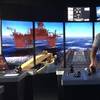At Hamburg port E-mobility Project, BESIC enters crucial phase
Ten battery-operated heavy goods vehicles now transport containers between ships and the yard at the highly automated handling facility in the HHLA Container Terminal Altenwerder (CTA). The aim is to charge the batteries of these container transporters when the grid has a surplus of renewable energy generated in northern Germany.
The first battery-powered heavy goods vehicles in the world went into use at the HHLA Container Terminal Altenwerder (CTA) back in 2011. Now, a project is bringing together businesses and research institutions that are keen to find out how the batteries for these automated guided vehicles (AGVs) can be charged using surplus green power generated in northern Germany. To this end, a battery administration system is being developed as part of the BESIC research project (Battery Electric Heavy Goods Transports within the Intelligent Container Terminal Operation).
The system calculates the ideal charging times – in both ecological and economic terms – by exchanging data with Vattenfall’s load forecasting system and the CTA terminal management system.
Dr. Stefan Behn, HHLA’s Executive Board member responsible for the Container segment, said: “The highly efficient HHLA Container Terminal Altenwerder is characterised by an advanced level of automation and electrification. We consistently use cost-cutting, environmentally friendly technology at this facility. Using eco-friendly technology is only truly sustainable if it costs less than conventional alternatives. I am confident that we can make successful use of surplus green power and reduce our energy costs as part of BESIC. With this project, we are bringing forward the energy transition. We are once again demonstrating that e-mobility makes sense both from an ecological point of view as well as an economic one.”
Dr. Oliver Weinmann, Managing Director of Vattenfall Innovation GmbH, added: “We are delighted to be working with a partner like HHLA, enabling us to take intelligent electricity management to the next level together. In order to do this, we are linking the future battery administration system with our load forecasting system and the terminal management system to identify suitable charging windows. If we succeed in realising clear cost reductions with this intelligent charging strategy, other logistics applications ould also benefit from it. In that case, we would develop a universal data standard based on the BESIC findings. This experience also gives us a real step forward as a system integrator for renewable energies in the market.”
Dr. Mathias Dobner, Managing Director of Terex Port Solutions, said: “With BESIC, we are building on established, tried and trusted AGV technology and battery technology which has proved successful in recent tests. Now, we are developing alternative systems using lighter batteries with a higher energy density and an intelligent battery administration system. With this system, we would like to ensure that the batteries of the AGVs are charged when surplus green power is available in the grid.”
Prof. Dr. Hans-Jürgen Appelrath, member of the Managing Board at the Energy Research Centre of Lower Saxony (EFZN), commented: “For electric mobility to succeed in practice, we need information and communication technology (ICT) which can manage fleets of electric vehicles with a pool of battery systems, for example. In addition to this, the Container Terminal Altenwerder simulation allows us to study the effects of different charging strategies. It also supplies predictive data about electricity requirements in connection with e-mobility which is relevant for the energy industry.”
As part of the BESIC project, standard diesel/electric automated guided vehicles are being compared with AGVs that are powered by conventional lead-acid batteries or by innovative lithium-ion technology. If the intelligent charging strategy significantly cuts operating costs, it could pave the way for heavy goods vehicles.
For the project, the companies Hamburger Hafen und Logistik AG (HHLA),
Gottwald Port Technology GmbH – which belongs to Terex Port Solutions – and Vattenfall have joined forces with the universities of Oldenburg, Göttingen and Clausthal, which are being coordinated by the Energy Research Centre of Lower Saxony (EFZN). BESIC is being subsidised by the Federal Ministry of Economic Affairs and Energy as part of its
technology competition “ICT for E-mobility II – Smart Car – Smart Grid – Smart Traffic”. ICT stands for information and communication technology. The project was rolled out in January 2013 and was already selected by the German government as a flagship e-mobility project in May 2013.










